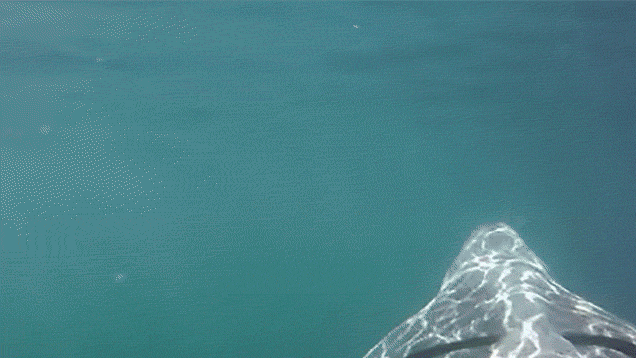Fisheries biologist John Shepherd once said that “counting fish is like counting trees — except you can’t see them and they move.” This can make animal behaviour research extremely difficult. And while increasingly advanced electronic telemetry tags can tell us a lot, there’s just no substitute for seeing a behaviour on video.
Knowing how animals behave in the wild is critical for conservation policymakers who want to regulate the environment in ways that reflect the reality of wild animal life. But how do you watch creatures who are outside human habitats? Increasingly, scientists are using animal-mounted cameras.
National Geographic’s CritterCam system has been deployed on more than 50 species of sharks, marine mammals, turtles and penguins, and similar technology is being used by research teams all over the world. Meanwhile the Inishowen Basking Shark Study Group in Ireland studies the world’s second largest fish, which can reach 12 meters in length and weigh up to 4 metric tons.
HeatherVance, a graduate student at Queens University Belfast, is using animal-borne video cameras to study the behaviour of these poorly understood animals. “I think the thing that interests me most about basking sharks is how mysterious they are,” Vance said. “There is still so much we don’t know about them and this means that when we study them we can find out things that no one ever knew before!”
These cameras also contain biologgers that can measure depth, 3D acceleration, compass heading, and other environmental variables. Combining video footage with this information can reveal much about the behaviour of basking sharks.
“For instance, we have investigated energy expenditure in relation to feeding strategies,” Vance said. “We hypothesized that when basking sharks open their huge mouths to feed they are creating a great deal of drag and swimming should become more energetically costly. Using the camera footage we were able to identify periods when the sharks were feedings. We then coupled this with our indirect measures of energy expenditure and found that sharks are expending more energy when feeding than when swimming with a closed mouth.”
After a few hours, the mechanism attaching the camera to the shark’s fin degrades, and the camera floats to the surface where it can be picked up by the research team. The initial results were exciting.
“Attaching a camera to a basking shark had never been done before anywhere else in the world. So on the most basic level, we wanted to try it out, and for the first time see the world from a basking shark perspective,” Vance said.
“The video footage itself, however, has allowed us to view never-before seen events such as basking sharks interacting with one another underwater, spending extended periods cruising on the seabed at slow speeds, a breach event from a basking sharks perspective and how a basking shark reacts to sharing the water with boats and people,” she continued.
When studying the video footage from the basking shark mounted cameras, Vance and her team also found something else: themselves!
The team joked about it on Twitter:
@WhySharksMatter @Gyrefalcon They wouldn’t be able to work a pinhole, but credit where credit is due, he (we think) took some great shots.
— Irish Basking Shark (@BaskingIrish) March 5, 2015
You can watch more of the footage from the first deployment of animal-borne cameras on basking sharks here:
